There are many benefits to using solar energy. For example, a solar panel system can get energy from direct sunlight to create power currents.
Once you install solar panels, you’ll likely notice your electric bill decrease.
If you’re curious about how much power output is coming from your solar power system, testing solar panels is the most accurate way to find out.
Knowing the solar panel output can give you a better idea of how much power your solar panel system can create. To get an accurate reading of how well your solar power system is working, it’s a good idea to test your solar panels regularly.
Solar panel testing is a simple process that can keep you informed of how efficient the solar panels really are.
On this page, we’re going to discuss how to test solar panels so you can get an accurate reading every time. We will discuss what you need to perform the test and measure the solar panel output correctly.
What affects solar panel output?
When you purchase new solar panels, they will be listed with the power they can produce. The manufacturer always states the amount of power the solar panel can produce when in ideal weather conditions.
Unfortunately, since you have absolutely no control over the weather, there’s a good chance that your solar panels aren’t seeing perfect weather daily.
Even if you live in a climate with weather that is considered ideal for solar panels, they will only be exposed to direct sunlight for a few hours each day. This is why it’s essential to test solar panels on your own to get an accurate reading of how well they are performing.
But, of course, many other factors could affect your solar panel output as well:
- For example, the location, the solar panel, is facing.
- Shading around the solar panel system
- Seasons
- Geographical location
Why do you need to test solar panels often
As mentioned above, weather and location play a big role in how much power output you can receive from your solar panels. Therefore, testing solar panels regularly is the best way to find out if you want to know exactly how much power your solar panel system is producing.
In addition, this test will let you know if the solar panels are meeting your expectations.
Many homeowners have discovered that they needed to extend their solar power system because the solar power test showed that their system wasn’t producing as much current as they needed.
Other homeowners have been able to get better output by readjusting their solar panels. However, if you want to get the most power from your system, you need to test a solar panel.
What you need to test a solar panel
To test a solar panel, you will need an amp meter and a multimeter. These devices are used to measure the voltage and wattage.
You will be able to read the dc amps of your solar panels by attaching the amp meter to both the positive and negative terminals to test the panel’s voltage rating.
Another helpful tool for getting a precise reading is a variable resistor box. You can use this to get readings for the solar panel with different levels of resistance.
If you do not own any of these devices, they should be available to find at local hardware stores or automotive shops. They are generally affordable, but prices can vary depending on features.
In some situations, you may find alligator clips to be helpful. For example, the alligator clips can make a temporary connection when you need to test the output of your solar converter box.
Types of multimeters
If you don’t have a multimeter already, you will likely notice two different types when looking to buy one. The two main styles of meters are switched and auto range.
Both styles of meters do an accurate job of reading the output of your solar panel system. The choice is a matter of personal preference.
You can adjust the switched multimeter manually. When using this device, you have control over the ranges to get the most accurate reading.
On the other hand, auto range will automatically adjust the device between ranges to get an accurate operating current measurement. Thus, both styles of multimeter are capable of the appropriate function to complete the reading.
How to test solar panels on your own
To accurately test solar panel output, you will need to calculate the wattage. You can do this by multiplying the Volts and the amps.
This means that you will need to test the solar panels to determine the volts and amps. You will need to do a few tests to get the measurements:
- Test before you estimate
- Measure the amperage
- Measure the current
- Calculate the panel’s output
Once you have recorded all of these, you can do a simple calculation to test the solar panels. But, first, let’s take a closer look at how to perform each step so you know how to test your solar panel system properly.
Step 1: Test before you estimate
Before the solar panel reaches the consumer, the manufacturer will run tests to determine the power rating. As a consumer, you should always assume the solar panel will produce less than that.
Also, keep in mind that the manufacturer will always test the solar panels at a steady temperature.
When you install them, your solar panels will be exposed to fluctuating temperatures and weather conditions. Testing your solar panels is important because most solar panels are not placed in areas that can produce the power listed on the package.
Many people judge the panel’s output by what is listed on the label, then are greatly disappointed when their electricity bill arrives. Testing your solar panels will give you an accurate reading, so you will know exactly how many panels are needed for your system.
Step 2: Measure the amperage.
For this step, you will need an amp meter. You will not be able to perform the test to read amp output without this device.
Before you measure the solar panel amperage, you will need to locate the positive and negative terminals on the solar panel.
There are a few things you should keep in mind when reading the dc amperage. First, you will not get an accurate amp output reading if you’re not testing it in the same conditions the solar panel is placed in.
This means you need to measure the solar panel amperage in the same location where it’s placed.
Measuring the amperage is a straightforward process. All you need to do is connect the amp meter’s positive and negative connections to measure dc amps.
Make sure you record your reading before moving to the next step.
Step 3: Measure the current (open circuit voltage)
You will need the multimeter for this step, and if you choose to use the variable resistor box, you will need it. Make sure you have the tools ready before you start.
Take a look at the back of the solar panel for the converter box. If there is a cover on the box, you will need to remove it.
Carefully review the instruction manual to locate the positive and negative connections. Of course, you must have the correct connections.
Once you know exactly where the connections are, you can connect the multimeter.
Like measuring the amperage, you will need to be in direct sunlight and in the same area where the solar panel would be located for an accurate measurement. Before you connect the device, you should make sure it is set to read dc voltage.
You should also confirm that the device is set to read a voltage higher than you expect the solar panel to read.
When connecting the multimeter to your solar panel, ensure the positive cable is connected to the positive terminal and the negative lead with the negative terminal. Always double-check that each connector is on the correct side, or you will not get an accurate reading.
Once you get your reading, always turn the device off before disconnecting.
Don’t forget to record the direct current reading before moving on to the next step.
Step 4: Calculate the panel’s output.
Now you have determined a reading for amperage and voltage (direct current) of the solar panel, it’s time to calculate the wattage. This is a straightforward equation for testing solar panels, amperage X voltage = wattage.
Multiply the readings you collect in steps 2 and 3 to determine the wattage.
While this calculation will show the daily watt-hours, keeping in mind is that this total measure current is for full sunlight. Therefore, for the most accurate reading, most homeowners will take 75 per cent of the total.
This is because they don’t expect ideal weather and sunlight conditions every day.
Test your solar charge controller
Some solar panel systems come with a solar charge controller. This is essentially a solar power voltage and current regulator.
They are typically used on off-grid solar systems to deliver the best power output for the system. This charge controller is designed to help keep current flowing without overpowering the battery.
A solar charge controller is only essential for systems when a battery is involved. Typically, these will not be necessary for smaller solar-powered systems.
If you want to test the solar charge controller, you will need to start by connecting the correct leads, make sure the positive lead is on the positive side and vice versa with the negative lead.
The meter should be at -10A. Once everything is ready, you can connect the solar panel, then the solar charge controller, and then the battery.
Then you will connect the solar charge controller to the battery. Next, disconnect the positive cable from the battery, and connect the meter to the positive side of the charge controller.
You will need to connect the meter’s negative connector to the battery’s positive terminal for the next step. This connection will show you the current passing from the solar panel and charge connector.
Again, you may need to use alligator clips to accept current.
Final Words
A solar panel can take natural energy from the sun and generate it into an electric current. Every type of solar panel is listed with a power rating.
It’s important to know that manufacturers always measure higher than what the solar panel system will actually generate. This is because your solar panel likely won’t see full sunlight 24/7 once it’s installed.
For a more specific calculation of your solar panel system’s alternating current, you should perform a test to see if the panels are working correctly and meeting your power needs. This can give you an idea if there is low voltage or if they need to be repositioned.
In some cases, you may need to extend the solar panel system to allow enough operating current for most household appliances.
One tip to remember before starting is that testing the solar panel system and using regulator measures is not complicated. However, you should always review the instruction manual first.
This is so you know exactly which is the positive lead and which is negative. This will prevent a false reading for the output of your solar panel.












